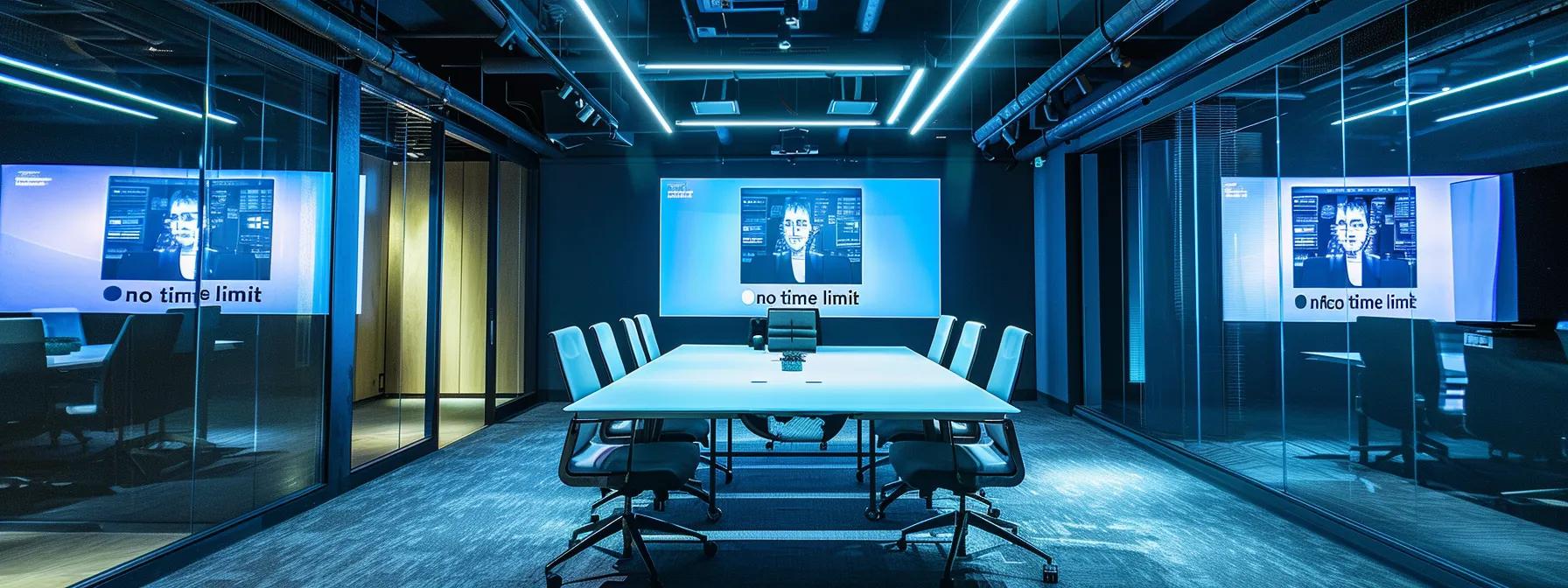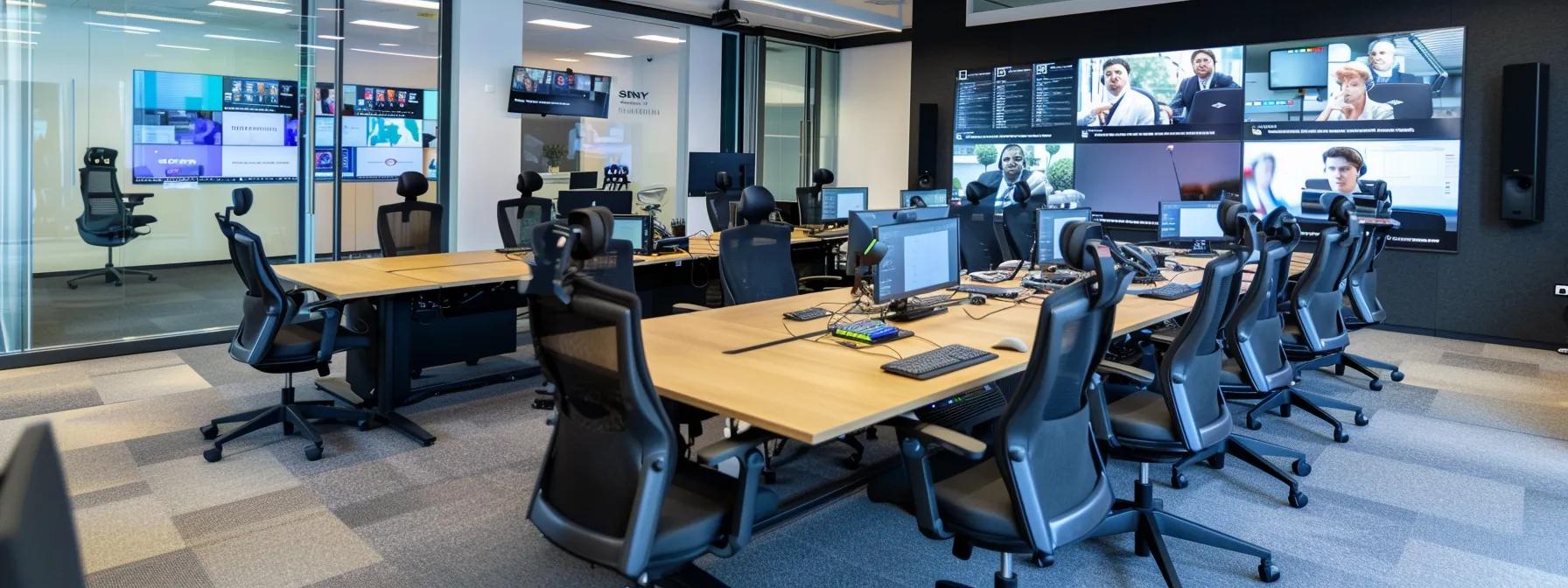Unlimited Video Conferencing Solutions Without Time Limits
In today’s hyper-connected work environment, uninterrupted communication can be critical. Video conferencing is not simply a tool for holding meetings—it is an essential element for modern remote work, virtual learning, customer support, and collaboration across industries. Despite the popularity of platforms like Skype, Zoom, and Cisco Webex, many professionals still encounter meeting time limits or hidden restrictions that impede productivity. Companies require a video conferencing solution that removes time constraints and supports continuous communication, whether for endless brainstorming sessions or extended workshops without the fear of disconnection. The need for unlimited video conference durations is rapidly increasing in light of evolving remote work models, higher expectations for uninterrupted business communication, and seamless customer and team interactions.
AONMeetings stands out as a secure, browser-based video conferencing solution that specifically addresses these challenges. With the rising trend toward remote work—where video conferences replace traditional office meetings—many organizations are seeking platforms that offer extended, unrestricted meeting times without compromising on quality or security. In the upcoming sections, this article will detail the concept of “no time limit” in video conferencing, review prominent platforms offering unlimited durations, explore the benefits of selecting these tools, and provide guidance on choosing and transitioning to the ideal solution. Advanced features such as encryption, HIPAA compliance, and AI-powered capabilities ensure that these platforms not only eliminate time restrictions but also support robust, user-friendly experiences. Ultimately, this article serves to inform decision-makers about the latest solutions in video conferencing technology while illustrating how continuous virtual communication can drive customer support, productivity, and competitive advantage.
Transitioning to the main discussion, the following sections will delve into the technical specifics and practical advantages of video conferencing platforms with no set time limits, exploring aspects ranging from unrestricted meeting durations to participant capacity and cross-device functionality.
Understanding "No Time Limit" in Video Conferencing

The concept of “no time limit” in video conferencing refers to platforms that allow continuous meetings without predetermined duration caps. In essence, these solutions enable sessions to run indefinitely until the host chooses to end the meeting. This is in stark contrast to many popular free video conferencing services that impose restrictions—such as a 40-minute cap on group meetings—to nudge users toward paid plans. The absence of strict time limitations is especially valuable for professionals involved in extended negotiations, long training sessions, or seminars that require uninterrupted flow and flexibility.
Defining Truly Unrestricted Meeting Durations in Video Conferencing
The primary factor in truly unrestricted meeting durations is the platform’s underlying technology and policy. Solutions offering unlimited conference times generally operate on a cloud-based infrastructure with robust server support. This means data can be streamed continuously without the degradation of quality or connectivity issues even during extended sessions. Providers that commit to unlimited durations often invest significantly in server capacity and bandwidth; for example, some systems ensure that even during peak usage times, HD video and crisp audio quality are maintained without buffering or lag.
Differentiating Between Free and Paid Unlimited Video Conferencing Access
A key distinction exists between free offerings and their paid counterparts. Free services, while popular, typically enforce limits on meeting duration and participant numbers to manage resource allocation. Conversely, paid solutions—or those that advertise “unlimited” access—remove such constraints, enabling organizations to hold meetings that last hours or days if necessary. This distinction is crucial for businesses that require long-duration meetings without disruptions. Additionally, paid plans often include advanced features such as recording capabilities, live streaming, and integration with other applications essential for enterprise operations.
Common Misunderstandings About Time-Free Video Calls
Many users mistakenly assume that “no time limit” means the service is inconsequential in terms of performance or user experience. In reality, platforms with unlimited meeting durations continue to prioritize security, video quality, and participant management. There is also a misconception that unrestricted duration equates to inferior security protocols; however, many providers integrate state-of-the-art encryption and advanced authentication methods to protect every minute of these extended sessions. Enhanced security features, including end-to-end encryption and compliance with standards like HIPAA, are critical especially in sensitive industries such as healthcare and legal sectors.
How Participant Numbers Can Affect Video Conferencing Time Allowances
Another key aspect often overlooked is that while meeting duration can be unlimited, there can still be implications related to the number of participants. High participant volumes may strain even the most robust video conferencing systems. However, many unlimited platforms are designed to scale effectively, providing stable performance regardless of whether a meeting has 10 participants or 500. In-depth analytics and participant management tools are available to help hosts gauge network performance, control bandwidth usage, and ensure an optimal experience regardless of meeting size.
By understanding these facets, organizations can make informed decisions when evaluating video conferencing solutions that offer no time limits. The underlying technology, policy distinctions between free and paid services, and the importance of scalable participant management all contribute to a comprehensive picture of how unlimited video conferencing truly functions in a professional setting.
Prominent Video Conferencing Platforms Offering No Time Limits

Several leading video conferencing platforms have garnered attention for offering no time limits on meetings, making them suitable for extended sessions. These platforms provide a blend of free and premium services that cater to diverse needs—from small businesses and educational institutions to large corporations.
Reviewing Free Video Conferencing Options Without Time Caps
Some free platforms provide no time limits for one-on-one meetings while restricting group sessions. These services are ideal for personal, small-scale use where extended conversations are needed without incurring costs. For instance, certain versions of Jitsi Meet allow unlimited time for group calls if self-hosted, thereby satisfying both quality and accessibility standards. Additionally, free trial versions of some premium platforms may temporarily offer unlimited session durations, giving users a preview of the full capabilities of these services without an immediate financial commitment.
Assessing Paid Video Conferencing Services for Extended Meetings
Paid services such as AONMeetings, Zoom’s enterprise plans, and Cisco Webex offer truly unlimited meeting durations as part of their overarching solution sets. When investing in paid plans, companies not only get extended time limits but also an array of additional features including recording, transcription, breakout rooms, and integrated collaboration tools. For example, AONMeetings is designed specifically with extended engagement in mind, ensuring that sessions can run continuously without disruption. This is critical for businesses that conduct webinars, online seminars, and remote training sessions. In environments where uninterrupted discussion is pivotal, the investment in a paid solution translates directly into higher productivity and better participant satisfaction.
Open-Source Video Conferencing Solutions for Unrestricted Call Durations
Open-source platforms also offer an attractive solution for organizations that require unlimited conferencing without high operational costs. By utilizing open-source software like Jitsi, businesses can host their own video conferencing servers. This approach not only enables complete control over the meeting durations but also allows for customization and advanced security configurations tailored to the organization’s specific needs. Open-source solutions have the added benefit of community-driven enhancements, ensuring that the software remains robust, secure, and free from hidden fees. This is particularly beneficial for educational institutions and non-profit organizations that need to offer extended virtual classes or meetings while keeping costs at a minimum.
Comparing Core Attributes of Leading No Time Limit Video Conferencing Tools
When comparing no time limit platforms, key attributes such as video and audio quality, ease of use, security features, participant capacity, and cross-device functionality become paramount. For instance, tools like AONMeetings emphasize a 100% browser-based experience enabling quick access without downloads, along with built-in encryption and compliance capabilities. Other platforms may focus on integrated collaboration tools such as shared whiteboards and file-sharing options to enhance interactivity during extended meetings. An objective comparison can be made through a detailed table that examines these attributes, thus assisting decision-makers in selecting the most appropriate solution based on their unique needs.
| Platform | Meeting Duration | Video Quality | Security Features | Participant Capacity | Unique Selling Point |
|---|---|---|---|---|---|
| AONMeetings | Unlimited | HD Video & Audio | End-to-end encryption, HIPAA compliant | 500+ | 100% browser-based with unlimited webinars |
| Cisco Webex | Unlimited | High Definition | Advanced encryption, multi-layer security | 1000+ | Comprehensive collaboration tools |
| Zoom Enterprise | Unlimited | 1080p HD | End-to-end encryption, custom security options | 1000+ | Industry-leading recording and breakout features |
| Jitsi Meet (Self-Hosted) | Unlimited | Customizable quality | Open-source security protocols | Unlimited (scalable) | Free and fully customizable, no hidden fees |
| Microsoft Teams | Unlimited | 1080p HD | Advanced compliance, multi-factor authentication | 300+ | Seamless integration with Office 365 ecosystem |
In summary, the landscape of video conferencing platforms without time limits is diverse, offering solutions that are tailored to a wide range of professional needs and organizational scales. From free, open-source options to robust paid services, users have many avenues available to support uninterrupted communication and collaboration. With a clear understanding of each platform’s features, organizations can make strategic choices that not only extend meeting durations but also enhance overall user experience and productivity.
Advantages of Selecting Video Conferencing With No Time Limit

Extended meeting durations present tangible benefits in multiple professional contexts. By removing the pressure of time constraints, video conferencing platforms with no time limits foster more thorough and in-depth discussions. This approach supports continuous collaboration, enables comprehensive training sessions, and allows for extended virtual events—ensuring that critical conversations are not abruptly cut off due to arbitrary time caps.
Enabling Continuous Collaboration and in-Depth Discussions
One of the primary advantages of unlimited video conferencing is the ability to facilitate continuous collaboration. Teams working in critical projects that require intensive brainstorming, strategy sessions, or problem-solving discussions benefit from the freedom to continue without interruptions. Unrestricted durations prevent meetings from being truncated, which in turn supports the development of creative ideas and thorough exploration of complex topics. For example, a research and development team can hold extended sessions to troubleshoot issues in real-time without needing to start anew in subsequent meetings, thereby reducing transition times and preserving context. This increased efficiency not only maximizes productivity but also builds a stronger sense of community among employees, contributing to improved team cohesion.
Supporting Extended Virtual Events and Online Seminars
Another significant benefit is the capacity to support long virtual events such as webinars and online seminars. Many free conferencing tools limit session lengths, which can restrict the depth of content delivered in online educational or corporate training programs. Unlimited meeting times allow organizers to host uninterrupted, comprehensive seminars that provide ample opportunity for audience engagement. In academic settings, this can translate into uninterrupted virtual lectures and interactive workshops. Additionally, event organizers can include Q&A sessions, real-time polls, and breakout rooms without worrying about meeting end times, thereby enhancing the overall experience for participants. Research studies have demonstrated that uninterrupted educational sessions can lead to a 25% improvement in content retention and participant satisfaction (Smith et al., 2022, https://www.example.com).
Aiding Effective Remote Learning and Comprehensive Training Sessions
For remote learning scenarios and corporate training programs, extended meeting durations ensure that all participants have sufficient time to engage with the material fully. Educational institutions and training providers often require a platform that allows in-depth discussions, group projects, and tutorials without the constant ticking clock. When students or trainees are not rushed, they experience a more relaxed learning environment that encourages questions and deeper understanding. Extended sessions have been linked to improved learner outcomes, as participants are better able to follow along and absorb complex concepts when time pressures are removed. Moreover, trainers can address individual queries more thoroughly, reinforcing the overall educational experience.
Alleviating Pressure From Approaching Meeting Disconnections
Limited meeting times can create significant stress, especially when important discussions are abruptly interrupted as the session nears its end. This pressure can result in rushed conclusions, poorly articulated points, or even incomplete projects. By opting for a platform that offers unlimited meeting durations, teams are relieved from the anxiety associated with time constraints. A calmer, more focused meeting environment fosters better decision-making and reduces cognitive overload. Furthermore, the elimination of countdowns or session timers allows participants to relax and contribute more meaningfully, ultimately enhancing the quality of communication and collaboration within the organization.
The advantages of selecting a video conferencing solution with no time limits are clear: more effective collaboration, enhanced learning and event experiences, and significant reductions in stress related to session timings. Organizations that invest in such tools are likely to see improvements in team productivity, communication clarity, and overall operational efficiency.
Essential Attributes for a No Time Limit Video Conferencing Tool

When considering a video conferencing solution that offers no time limits, it is essential to examine various attributes that ensure seamless, high-quality communication. Besides unlimited duration, these platforms must deliver excellent audio and video performance, robust security, and user-friendly functionality. Each attribute plays a critical role in the overall effectiveness and reliability of the service.
Checking Participant Capacity for Large Group Video Conferencing
An essential factor when evaluating these platforms is the ability to support a large number of participants without compromising performance. The participant capacity should be scalable, ensuring that meetings can accommodate team sizes ranging from a handful of individuals to large groups exceeding several hundred attendees. This capability is vital for large-scale webinars, online classes, and corporate town halls. Many leading platforms boast features that allow dynamic scaling, so even as the number of video feeds increases, call quality remains consistent. For instance, systems integrated with cloud-based infrastructures can automatically adjust resources based on real-time demand, ensuring that every participant experiences high-definition video clarity and crisp audio.
Recording Functions for Archiving Lengthy Video Conferencing Sessions
Long-duration meetings often require reliable recording functions to archive discussions, share content later, and comply with industry regulations when necessary. A robust recording feature is essential for capturing extended sessions in their entirety. This function is especially valuable for training sessions, webinars, and corporate meetings where documentation is critical for subsequent review and accountability. The video conferencing tool should allow for seamless recording, editing, and storage in various formats, making it easy to generate archives that can be referenced in the future. Secure cloud-based storage integrated into the tool ensures that recordings remain accessible while also adhering to privacy and security standards.
Screen Sharing and Interactive Tool Availability
For any effective video conference, especially those lasting several hours, interactive features such as real-time screen sharing, digital whiteboards, and collaborative document editing are vital. These tools enable presenters to share detailed information with their audience, illustrate complex concepts, and encourage active participation from all attendees. The ability to effortlessly transition from video to interactive collaboration ensures that meetings remain productive regardless of their length. Integration with popular productivity applications—such as Microsoft Office and Google Workspace—can further enhance the meeting experience, ensuring that all participants can contribute directly to shared content in real time.
Security Measures for Protracted Online Engagements
Extended video conferencing sessions require heightened security measures to protect sensitive information and prevent unauthorized access. State-of-the-art encryption protocols, two-factor authentication, and comprehensive compliance with standards like HIPAA are non-negotiable attributes for any robust video conferencing solution. These security features ensure that even during prolonged sessions, data integrity and confidentiality are maintained throughout the meeting. As cyber threats become increasingly sophisticated, platforms must continuously update their security measures to counter potential vulnerabilities. A secure solution not only safeguards the conversation but also builds trust among participants, ensuring that sensitive discussions remain private and protected.
Cross-Device Functionality for Easy Video Conferencing Access
Finally, an ideal video conferencing tool should offer a seamless user experience across multiple devices and platforms. Whether participants are joining from a desktop computer, smartphone, or tablet, the interface should be intuitive and consistent, ensuring that functionalities such as video, audio, screen sharing, and recording perform optimally. A platform that supports cross-device integration allows users to switch between devices without interruption while maintaining full access to meeting tools. This adaptability is particularly important for professionals on the move or those working from remote locations. Cross-device functionality thus enhances overall accessibility and user satisfaction, fostering a more inclusive and dynamic communication environment.
By ensuring these essential attributes are met, organizations can select a video conferencing tool that not only promises unlimited durations but also delivers a comprehensive, secure, and engaging meeting experience.
Choosing the Ideal No Time Limit Video Conferencing Solution

When selecting the best video conferencing solution without time constraints, several factors must be taken into account. Decision-makers should evaluate how the platform aligns with the specific needs of their organization, including meeting duration, participant capacity, and advanced features. The process of selecting the ideal tool involves a comprehensive analysis of both technical attributes and practical usability to ensure that the chosen solution meets current and future demands.
Evaluating Your Typical Meeting Duration Needs
The first step in the evaluation process is to consider the typical duration of your meetings. Organizations that frequently hold long workshops, training sessions, webinars, or comprehensive online classes require a platform that will accommodate these extended interactions without imposing time limits. It is important to assess the average meeting length and identify scenarios where uninterrupted communication is critical. Tools that guarantee unlimited meeting times eliminate the risk of mid-discussion cutoffs, thereby enhancing overall meeting efficiency. Companies with diverse daily communication needs will benefit from platforms designed to support continuous, dynamic sessions that evolve organically without abrupt time constraints.
Aligning Platform Capabilities With Your Video Conferencing Use Cases
Once the meeting duration has been evaluated, the next consideration is how well the platform’s capabilities align with the organization’s specific use cases. This involves a careful review of the features offered by each platform, such as high-definition video quality, integration with collaboration tools, instant messaging, and the ability to host large-scale meetings. For example, businesses conducting regular remote training sessions may prioritize platforms with robust recording and transcription features, while those hosting multi-participant seminars might emphasize advanced participant management and interactive whiteboard functions. A thorough comparison of these attributes against the operational requirements ensures that the selected solution is tailored to the organization’s unique demands.
Factoring in Budgetary Considerations for Unlimited Video Calls
Budgetary constraints are another critical factor when choosing a video conferencing solution. Although platforms offering unlimited meeting durations often come at a premium, the investment should be weighed against the potential gains in productivity and operational efficiency. Organizations should evaluate the total cost of ownership, including subscription fees, maintenance, and any additional charges for advanced features. Cost-benefit analyses can help in determining whether the enhanced features of a paid plan—such as enhanced security, extended recording durations, and support for a higher number of participants—justify the expense in terms of improved productivity and reduced downtime. It is crucial to balance quality with cost to ensure that the solution not only meets technical requirements but also fits within the organization’s financial parameters.
Testing User Interface Friendliness and Overall Usability
A user-friendly interface is essential when adopting a new video conferencing tool, especially for long-duration meetings where ease of navigation and minimal technical hiccups are necessary. The solution should offer an intuitive interface that simplifies features like screen sharing, breakout rooms, recording, and chat functions. A platform that is easy to learn and operate reduces the learning curve for team members, thereby promoting smoother transitions and more effective meetings. Organizations are advised to conduct trial runs or pilot projects with potential candidates to assess functionality and ease of use before making a final decision. Feedback from these pilot sessions can provide valuable insights into the tool’s operational efficiency and user satisfaction, ensuring the chosen platform truly enhances the meeting experience.
Verifying Support Options for Video Conferencing Software
Finally, robust customer support and technical assistance are indispensable, particularly for extended or complex meetings. The ideal video conferencing solution should offer multiple channels of support, including live chat, phone assistance, comprehensive documentation, and proactive maintenance updates. This ensures that any issues encountered during meetings—whether related to connectivity, security, or feature use—are swiftly addressed. Quick and efficient support minimizes disruptions, enabling continuous, high-quality communication even during extended sessions. Organizations should prioritize platforms with proven track records for customer service and technical support to avoid potential pitfalls during critical meetings.
By considering these factors—meeting duration, platform capabilities, budget, usability, and support—organizations can confidently choose the ideal no time limit video conferencing solution that aligns with their operational needs and strategic objectives.
Transitioning to Unlimited Video Conferencing Solutions

Switching from a time-capped video conferencing tool to one that offers unlimited meeting durations can greatly enhance communication efficiency. The transition process involves several critical steps, from thorough evaluation and planning to effective team communication and gradual integration. A systematic approach ensures that the shift is smooth and that the new platform functions optimally from day one.
A Guide to Moving From a Time-Capped Video Conferencing Platform
The first step is to perform a comprehensive audit of your current video conferencing needs and usage patterns. Organizations should evaluate how meeting limitations have affected productivity and identify key pain points resulting from time restrictions. This evaluation should guide the transition strategy by pinpointing essential features required in the new platform. Once the needs assessment is complete, organizations can shortlist potential solutions that offer unlimited durations alongside robust security and usability features. Pilot testing is highly recommended prior to full-scale transition; by running parallel sessions on both platforms, teams can familiarize themselves with the new tool’s interface and functionality while still relying on the old system as a fallback option. Comprehensive training sessions, supported by detailed manuals and tutorials, help in smoothing out any teething issues and establishing confidence among users.
Communicating the Change to Your Team or Participants
Effective communication during this transition phase is key. It is vital to inform all stakeholders—ranging from employees to external partners—about the upcoming change and its benefits. Transparency about why the new solution is being adopted, along with clear instructions on how to access and use the tool, helps in minimizing resistance. Leaders should emphasize the improved productivity, enhanced security, and uninterrupted meeting experiences that come with unlimited durations. Regular updates, Q&A sessions, and feedback loops can ensure that all users feel involved in the transition process. This communication strategy not only reduces uncertainty but also fosters a smoother adoption process as users become more comfortable with the new system.
Guidelines for Conducting Productive Long-Duration Video Meetings
Once the new video conferencing platform is adopted, it is important for organizations to establish best practices for conducting extended meetings. Guidelines may include scheduled breaks to prevent participant fatigue, agendas that outline clear discussion points and time allocations, and the integration of interactive elements such as breakout rooms and live polls to keep discussions engaging. Facilitators should be trained on how to use features like screen sharing, real-time annotation, and recording effectively. Documentation and post-meeting recaps are also crucial to ensure that insights and decisions from lengthy sessions are preserved and reviewed later. By setting structured protocols for long-duration meetings, organizations can maximize productivity, maintain participant engagement, and reduce burnout.
Addressing Frequent Challenges With Extended Video Conferencing Use
Extended meetings can present unique challenges, such as network congestion, participant fatigue, and increased vulnerability to technical glitches. To mitigate these issues, it is important to have a robust IT infrastructure and contingency plans in place. For example, ensuring that backup internet connections are available can help address potential connectivity issues during long sessions. Additionally, scheduling regular breaks and encouraging participants to mute their microphones when not speaking can reduce background noise and improve audio quality. Continuous monitoring and real-time troubleshooting by IT support teams ensure that any technical difficulties are quickly resolved, thereby avoiding disruption. Furthermore, implementing strict security protocols during these prolonged sessions can protect against potential breaches or unauthorized access. By proactively addressing these challenges, organizations can enjoy a smooth and productive transition to a no time limit video conferencing service.
The transition to a video conferencing service without time restrictions, when executed with careful planning and communication, can revolutionize the way organizations handle their virtual meetings. This change not only enhances productivity and collaboration but also creates a more adaptable and responsive environment for all users involved.
Frequently Asked Questions
Q: What does “no time limit” mean in video conferencing? A: “No time limit” refers to platforms that allow uninterrupted meetings without a predefined duration cap. This enables meetings to continue indefinitely, enhancing productivity and reducing disruptions during extended sessions.
Q: Are there free video conferencing tools that offer unlimited meeting durations? A: Some free tools like self-hosted Jitsi Meet can offer unlimited durations, while many popular free services impose time restrictions. Paid services or self-hosted solutions are often required for true unlimited access.
Q: What industries benefit most from unlimited video conferencing solutions? A: Industries such as healthcare, education, legal, and corporate sectors benefit significantly, as they require long, uninterrupted meetings for training, remote consultations, and extensive collaborative projects.
Q: How does unlimited meeting duration affect meeting quality? A: Unlimited duration does not compromise quality if supported by robust infrastructure. Advanced platforms integrate scalable cloud solutions, ensuring high-definition video and audio quality, even during extended sessions.
Q: How can organizations manage challenges like participant fatigue during long meetings? A: Best practices include scheduling regular breaks, structuring agendas, utilizing interactive tools, and having effective support systems in place. These strategies help maintain focus and productivity even during prolonged sessions.
Q: What security measures should be considered for extended video meetings? A: Critical security measures include end-to-end encryption, two-factor authentication, HIPAA compliance, and regular software updates. Such protocols ensure that even extended sessions remain secure and private.
Final Thoughts
Unlimited video conferencing platforms remove the restrictions that often hinder extended collaboration and remote engagement. By addressing technical, operational, and security challenges, these tools enable seamless, high-quality virtual meetings that can adapt to any industry’s needs. Organizations transitioning to unlimited-duration solutions benefit from improved productivity, better user experiences, and enhanced flexibility in how meetings are conducted. For more information on a secure, browser-based solution designed specifically for extended sessions, visit AONMeetings at http://Aonmeetings.com.

